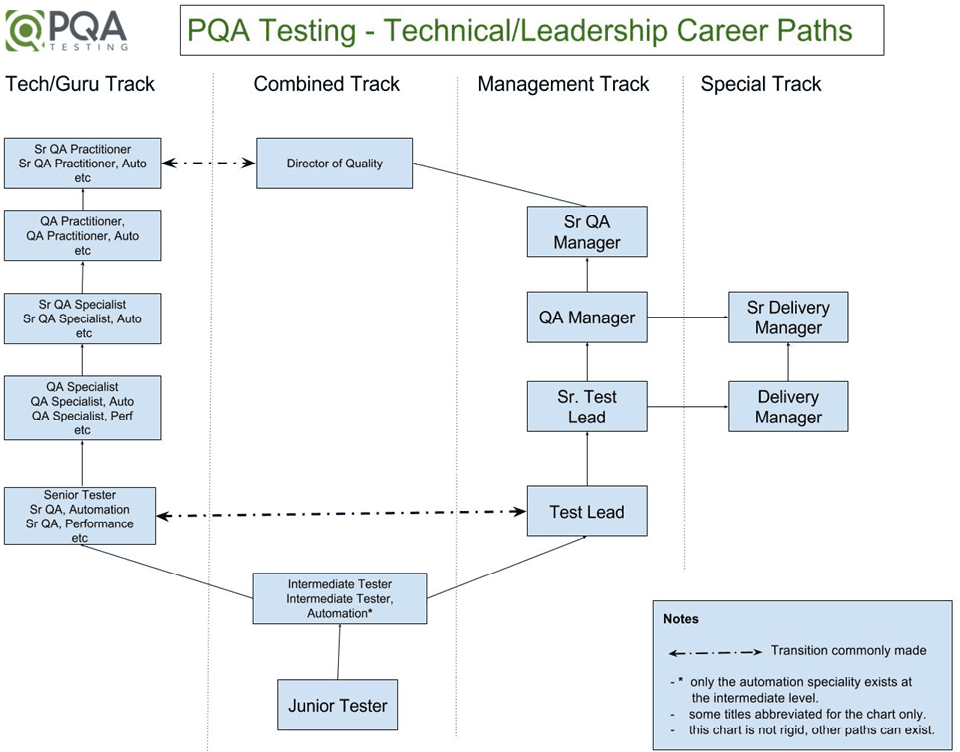At PQA Testing, we believe in a people-first mentality when it comes to career path and growth trajectory. By investing the time to have a solid and, most importantly, fair approach to titles and roles, we have found that a progressive approach for the protection of diversity has evolved.
Three years ago, we had a fairly standard set of titles and job descriptions that was relatively cohesive, as well as comprehensive, but didn’t really address the issue of the Senior Plateau. The Senior Plateau is the idea that when a resource hits and spends some time at the senior level they come to their manager and ask how they are going to grow in their three R’s. The three R’s, respect, responsibility and remuneration, are widely believed to be the pillars of job happiness and satisfaction.

Traditionally in IT professions, this conversation with your manager has generally returned the answer that to move up you had to make the jump to management. There are any number of reasons that being a manager is unappealing to your average tech worker (managing people and their problems, dislike of paperwork and admin, etc.) but additionally, it just doesn’t scale. There simply are not enough positions in management for all of the seniors out there. This does mean, however, that there’s nowhere for that senior to progress in their career. As such, they are more susceptible to that inevitable phone call from a recruiter where they are offered a lateral leap to a company doing something new to them. A new challenge with interesting new things to learn is the best they can hope for in this scenario and, after all, being challenged at work is the fourth pillar to job happiness and satisfaction.
This creation of the technical nomad, as seniors move on in quest of the three R’s, has numerous costs to the business they are leaving. Replacement costs are high, lost knowledge impact is immeasurable and cultural and leadership repercussions are felt for far longer than it takes to replace the individual.
At PQA, we believe in retention for more than protecting our investment in people, we believe that the longer employees are with a company, the more that they contribute and build the culture. In order to combat the Senior Plateau, PQA implemented a career path growth plan that includes a Tech/Guru Track, a way for seniors to grow their three R’s without becoming management.
If you look at Figure 1 below, you can see the swim lanes that we’ve developed for our career growth. To be clear, someone entering PQA can join in the chart where their skills and experience place them but, for this conversation, let’s discuss someone starting at the lower level. Starting from the bottom, every tester at PQA lives in the combined track, where they are learning the foundational skills necessary to work with a testing mindset making the right testing decisions.
When a tester is growing out of the intermediate level they begin to have conversations with their manager about where they feel their career should take them. They make a completely non-binding decision to follow either the Management or the Tech/Guru Track and, together, the manager and employee put together a growth and training plan that helps them learn the skills that they are going to need as they move up that track. At any time, they can initiate a conversation where they try to get flipped over to the other track. There’s no penalty, your training plan will have to be updated and you might have to backfill some skills.

As you move up either side, there are parallels between the two tracks. For example, there is room for pay ranges to increase for each track as you progress past the senior/lead level. As you move up the Tech/Guru Track, your responsibility and respect grow: you are expected to be a technical leader, mentoring people below you on the chart, helping choose tools, guide technology and methodology direction for the company and begin to act at the process consultant level with clients.
Within the Tech/Guru Track, there also exists the notion of specializations, or as we often put it, ‘commas’. By taking any title on the Tech/Guru track, adding a comma and then a specialization, such as automation, performance, security, data analytics or compliance, you denote that you have specialized in your skills. This helps in classifying the work you are best suited for and most appreciate doing. A non-comma’d person might have knowledge about automation or performance testing but not to the depth of capability that is required of the expert with the comma. As you move up the track, the skills matrix helps define the skills that you need to have within the specialization. For example, a Senior QA, Automation needs to be proficient with one automation framework while a QA Practitioner, Automation has to be proficient with three or more automation frameworks.
We talk a little bit at PQA about how Title and Role relate to different things. Title refers to who you are, what your skills are, what your general career path and goals are, any specializations you might have and the pay band that you fall into. Your role, conversely, refers to the group of tasks that are your responsibility in a current client engagement. A QA Practitioner might be doing a very technical engagement with a client but may have to do some of the Test Lead role tasks, such as status reporting and client communication for the team to ensure that things run smoothly.
Transparency is one of the key goals of the career path process. You know where you are, where you can go and what you need to do to get there. This protects diversity in that the criteria for having a title are clearly outlined and the same for everyone. A manager knows these criteria and can have growth conversations with their people to help them gain the skills to make it to the next title. People who are more assertive or extroverted are not rewarded with management jobs that restrict the growth of more reserved but just as talented individuals. At PQA, we also recognize the fact that there is as much value in core, foundational testing skills as there are in the specializations. This means that if you are not a coder but still have valuable experience that you can be paid comparably – I haven’t been able to find a statistic to back this up but a quick look at my network indicates that male-female ratios in automation are a lot more male-skewed than in manual testing.
There are many factors contributing to diversity at PQA but it takes many factors to have a welcoming working environment for a diverse workforce. Having a modern approach to titling and roles is a fundamental cornerstone in your diversity strategy.

